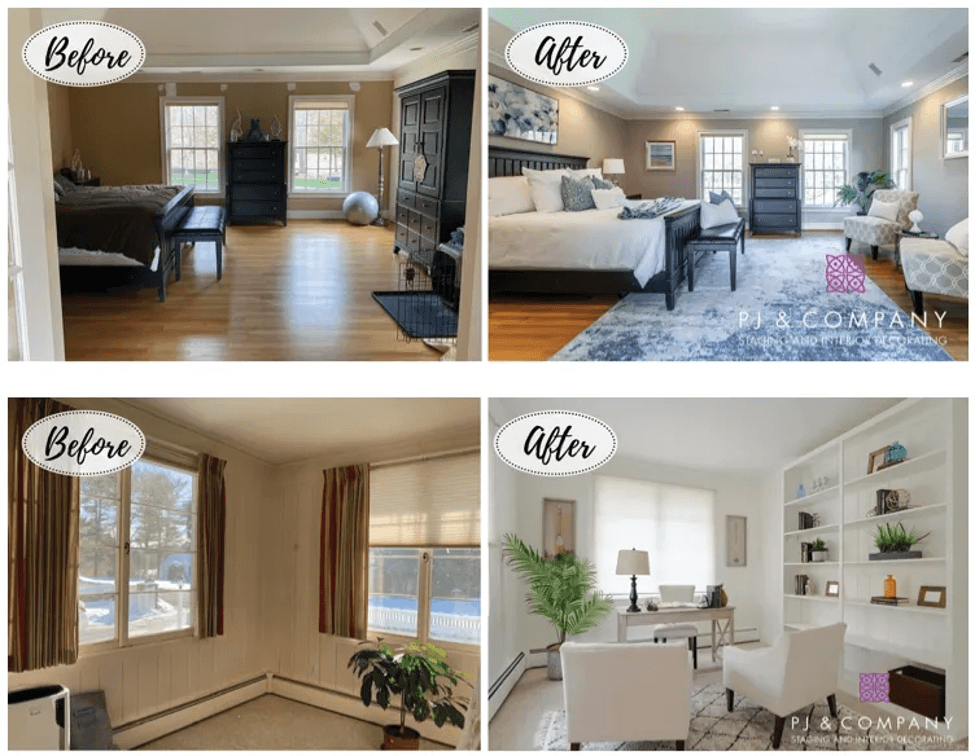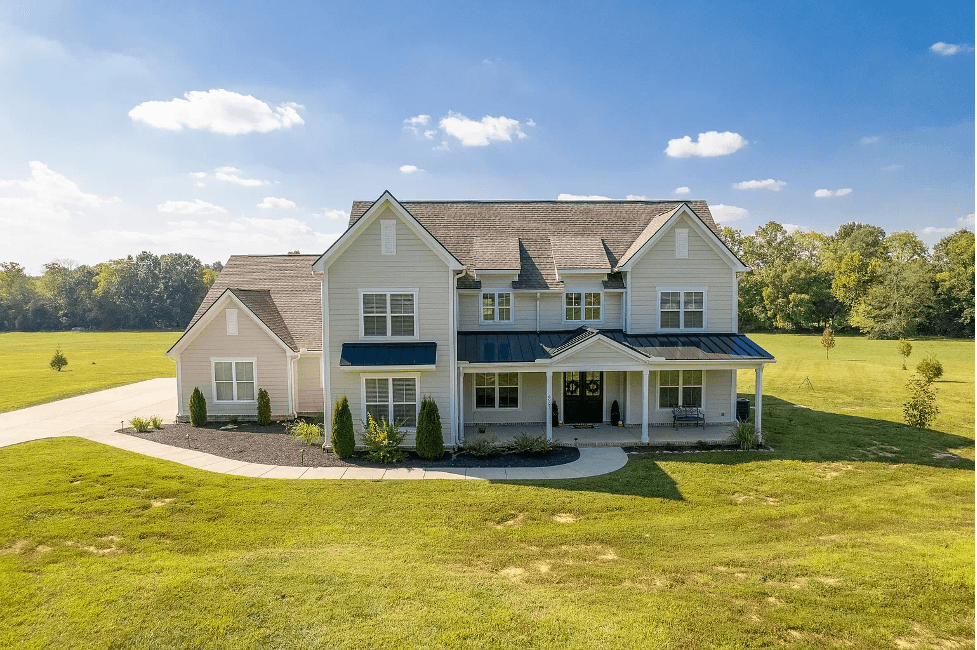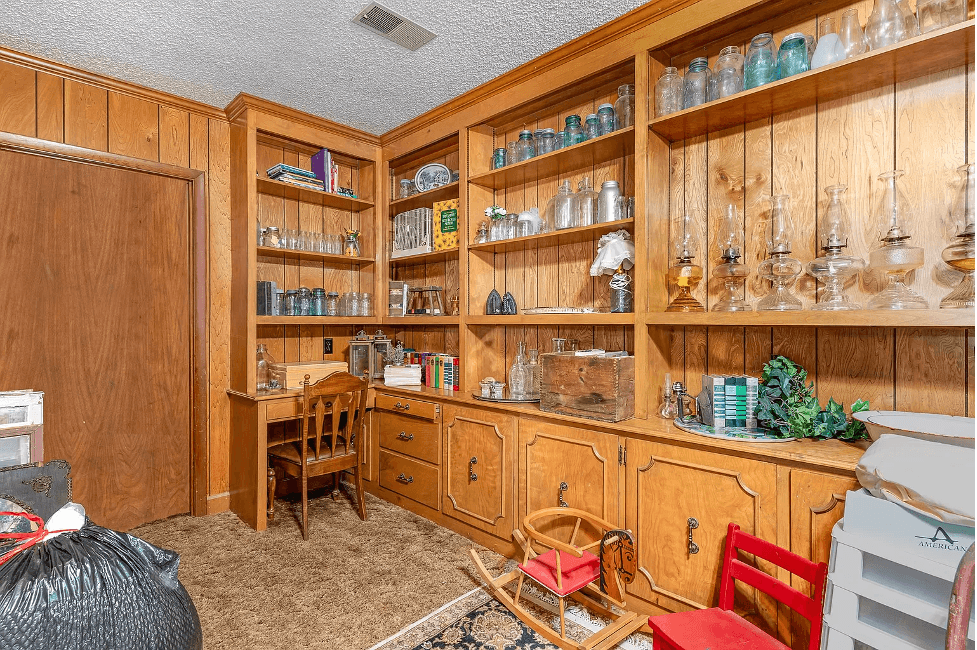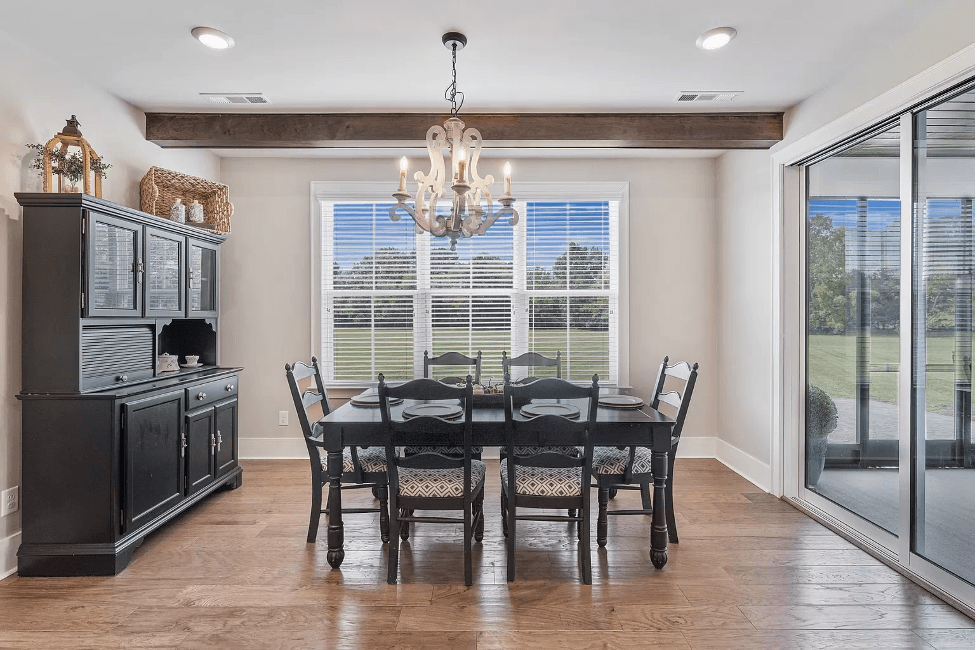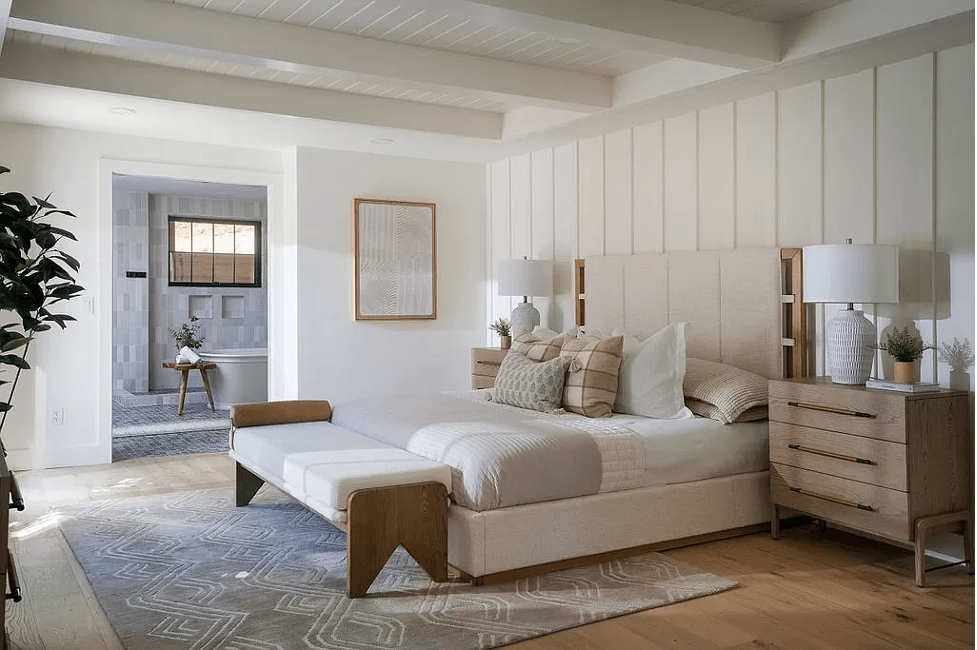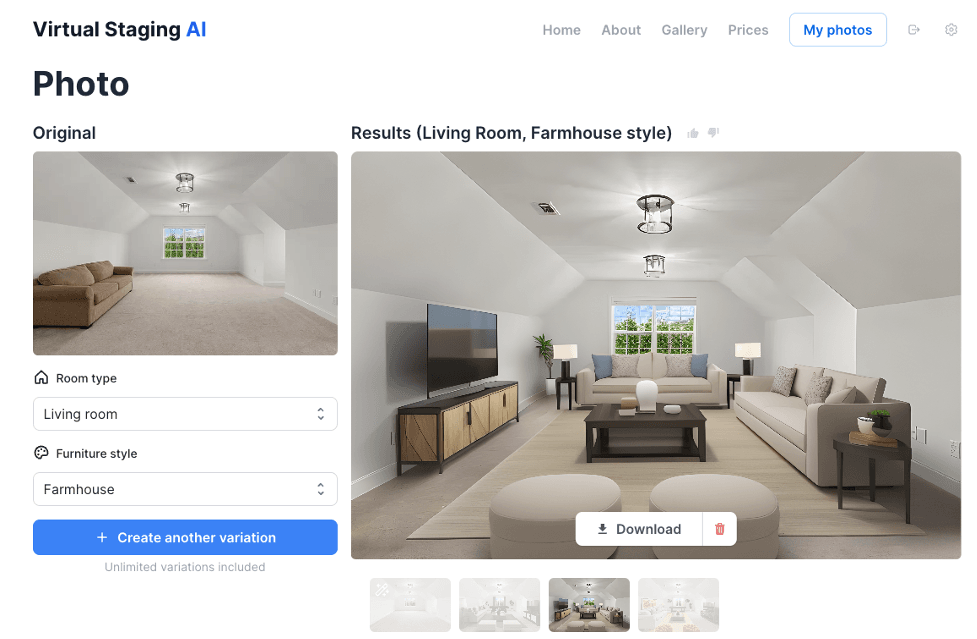January 12, 2024
11 Home Staging Tips for Real Estate Professionals
Home staging is a crucial part of selling real estate. Prospective buyers want to be able to envision themselves living in a space, so it’s crucial to ensure that a property is carefully styled to bring that goal to life.
Although there are many professional stagers for hire, anybody can stage a home with some guidance and preparation.
This article will discuss home staging and its benefits for selling properties. From there, we’ll provide some actionable tips to help you every step of the way. To wrap things up, we’ll cover when to consider hiring a professional.
What is Home Staging?
Home staging is a technique that real estate agents use to prepare a home for showings.
If you’re unfamiliar with this process, it involves curating an appealing experience for potential buyers by cleaning, fixing, and styling each room.
The idea is to make the home attractive so potential buyers can visualize themselves in the space. Why? A house is a significant purchase backed by an equally huge decision.
How the numbers read on paper will tap into rational decision-making. But the experience of visiting the home and seeing it staged will tap into emotional decision-making.
With that, the desired result of a well-staged home is the potential for increased profit for the seller.
As a realtor, conversations about staging should happen soon after a seller approaches you with the listing. These conversations should touch on decor options, establish a repair timeline, and address any unpleasant smells or landscaping issues.
Staging a home is relatively simple for realtors to do on their own. Many realtors even encourage sellers to stage their own homes with some guidance. More significant listings may require the help of a professional, but we’ll discuss this in more depth later in this article.
Benefits of Home Staging
As mentioned, the goal of home staging is to maximize profits on the sale of the home. Proper home staging can reach that goal thanks to a few built-in benefits.
For example, home staging makes a home more visually appealing and helps potential buyers visualize it as their future home. In fact, 82% of agents representing buyers said that a staged home helped their clients see a property as a future home.
Again, this taps into that emotional decision-making and can result in a faster sale and higher selling price. This is extremely valuable for most sellers.
Preparing the Home for Staging
Before you get into curating the aesthetic of your listing, you’ll need to prepare the home. This involves cleaning and stripping the property down to the basics.
Tip #1: Deep Clean
Deep cleaning is the first step to preparing your listing for staging. This gives you a blank canvas to start with, in a sense. Your client can either deep clean on their own or hire a professional cleaning service.
If your client opts to deep clean the property independently, remind them that every surface needs to be cleaned with great attention to detail. They should clean the floors, walls, light fixtures, bathrooms, bedrooms, sinks, toilets, bathtubs, showers, grout, microwave, and oven.
Even if your client is willing to clean, you should urge them to hire a professional if it’s within the budget. If they are on the fence, remind them of the actual value of the service. A professional team can do what may take the average person days in a matter of hours.
When it comes to deep cleaning, don’t neglect the exterior. A quick power wash of the driveway, siding, decks or patios, and other exterior features can spruce up a place.
Tip #2: Declutter and Depersonalize the Property
Decluttering is another major part of staging that helps potential buyers picture themselves in a home. Nobody likes clutter, so removing trinkets, household items, and other random objects from the space can help them picture it as a clean slate.
Not sure what clutter to avoid? Here’s a great example of a listing featuring dozens of personal items, making the room appear small, dark, and crowded.
Instead, take inspiration from this neatly staged dining room with minimal clutter. It appears spacious and bright.
You can take this a step further by depersonalizing the property. You can remove excess furniture, personal photos, and unnecessary decor. Approach this task with the mindset of “less is more.”
Your buyer may be waiting to get offers on their property before buying a new place, so there may be a time when their personal items may not have a place while the home is being shown.
Encourage them to move overflow items into self-storage to free up space and create a more open and appealing environment for potential buyers.
Tip #3: Make Small Repairs
Damage to a home, ranging from minimal to more significant, isn’t conducive to a positive experience for prospective buyers.
From minor dings in the wall to missing receptacle covers, damage is a surefire way to discourage buyers from putting an offer on your listing. That’s why it’s so essential to make minor repairs.
Fixing any issues can maintain a fresh feeling in the home and prevent distractions for prospective buyers. Some commonly needed improvements include:
- Touching up paint
- Repairing fixtures
- Upgrading door knobs
- Replace cabinet handles and drawer pulls
- Upgrading receptacle and lightswitch covers
Even though these repairs may seem small, they can significantly impact the home’s sale. They’ll show potential buyers that the home you are selling has been maintained with great care and quality products.
Again, these can be expensive, but don’t overdo them — this can impact your ROI.
Tip #4: Plan Each Room
Another essential part of preparing to stage a property is developing a clear plan for each room of the house. The key areas you should focus on include the living room, master bedroom, and kitchen.
While it’s essential to keep the entire home tidy and clean during showings, these are the primary living spaces in most houses, making them the most important.
Assess each room to determine what it needs regarding repairs or special cleanings. From there, think of which items need to be removed from the room if you show the house while it’s still owner-occupied. You can also think about how you’d decorate at this point.
Adding Visual Interest to Your Space
Once your listing is cleaned and prepped for staging, it’s time to design the space to make it visually appealing. Here’s how.
Tip #5: Add Fresh Coat of Paint
A lived-in home naturally wears down and damages paint on the walls. Whether your client has put holes in the wall to hang decor or has just scratched and scuffed walls with day-to-day life, a fresh coat of paint is a simple way to transform a space.
If you decide to paint as part of staging your home, there are a few things to remember.
For starters, sticking to neutral shades will appeal to a broader audience. It’s also vital to avoid vibrant colors in the spirit of creating a clean slate for new owners. Keeping it neutral will help make the space move-in-ready.
On that note, it’s also essential to avoid putting up wallpaper when staging a home. Wallpaper can be extremely difficult and messy to remove. Many wallpaper patterns are bold choices that may not jive with potential buyers, so it’s best to avoid them altogether.
Tip #6: Stick to a Neutral Color Scheme
As we briefly mentioned, using neutral colors (like gray) in home staging appeals to a broader range of potential buyers and provides a blank canvas for them to envision their own decor.
For example, these cool tones from Sherwin-Williams offer a good place to start
Choosing neutral paint colors is a start, but this can be taken a step further by opting for neutral decor. Pick decor that’s subtle and tasteful to keep the palette soft.
Tip #7: Maximize Natural Light
Natural light is a practical and affordable tool for elevating the appearance of a property. That’s because natural light makes rooms feel brighter and more spacious. Plus, it naturally has a positive impact on potential buyers’ moods.
You can maximize natural light in your listing by uncovering windows, using see-through curtains (or no curtains), and strategically placing mirrors to reflect light. You should also be careful not to obstruct natural light with furniture or decor.
Design the Rooms
Interior design is a huge part of staging a home. Cleaning and making small repairs are a great start, but the furniture and decor will bring everything together.
Tip #8: Choose Furniture Wisely
The furniture you choose can make or break a space, so it’s essential to choose wisely. Luckily, you can furnish a home for staging on a budget by focusing on the rooms that matter most.
Many professional stagers rent out pieces to stage a home, and you can do the same. Since this is a local service, it’s wise to ask around among other local real estate professionals. You can look online for furniture rental companies, but personal recommendations are often more valuable.
On that note, some sellers or listing agents may stage a home with purchased furniture rather than rented furniture. This is typically only the case for luxury homes with high listing prices meant to be sold furnished.
As you choose furniture, keep the goal of creating a spacious and inviting atmosphere at the forefront. You can do this by ensuring the furnishings are the proper size for the space.
If you’re unsure where to start when choosing furniture, using Virtual Staging AI is a great way to get inspiration.
Tip #9: Add in Throw Pillows and Potted Plants
Furniture is just the start when it comes to styling a property.
Throw pillows and other accessories add dimension to otherwise neutral rooms. When styling a room with throw pillows, ensure nothing clashes, including colors and patterns. Keep things simple.
Plants are also great for adding life to rooms since they add a bit of color without compromising neutrality.
Strategically placing plants can help hide imperfections and distract from less desirable views outside the windows. Plus, plants have natural mood-boosting properties, which is undoubtedly a win when trying to sell a home.
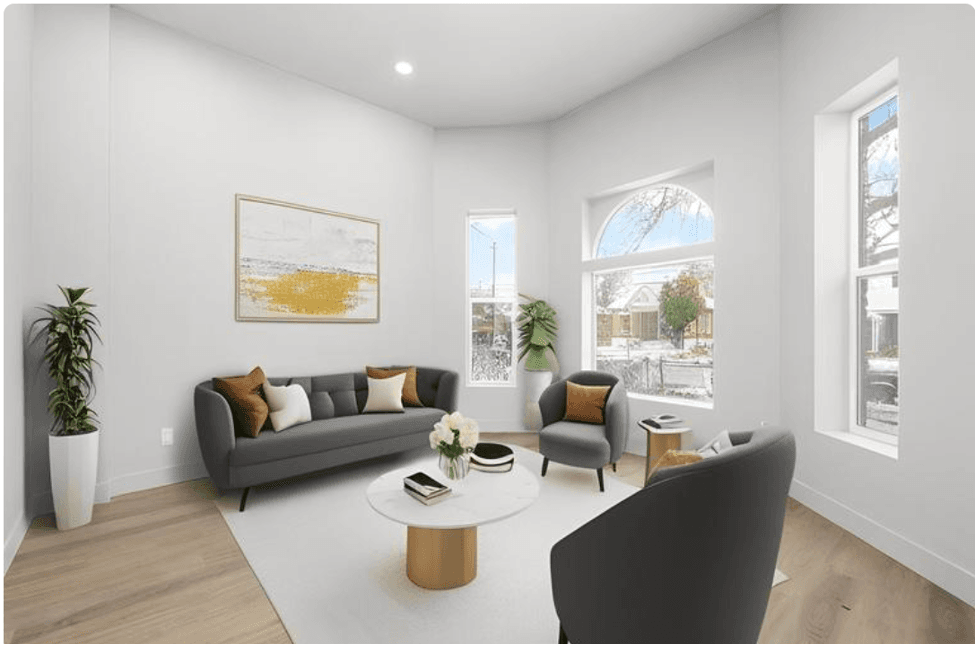 Virtual rendering by Virtual Staging AI
Virtual rendering by Virtual Staging AI
There are plenty of types of potted plants that you can use to fill empty spaces around the property, such as flowering plants, lush tropical ferns, and simple succulents.
Since they are low-maintenance, succulents and cactuses are great, but flowering and tropical plants are great if you want to add some pizazz.
Tip #10: Choose Decorative Items and Accessories
Beyond throw pillows and plants, you’ll want to incorporate decorative items and accessories throughout the house.
For example, the kitchen isn’t a place where you’d automatically think about decorating, but there are some things that you can use to spruce it up and make it more appealing to potential buyers.
Consider items such as upscale cookware, designer appliances, gourmet accessories, artful dinnerware and glassware, and other tasteful decorative pieces.
In other rooms around the house, consider styling with items like vases, candles, and sculptures to add some flare. Books are an affordable way to add a level of sophistication to any space, as well.
Tip #11: Don’t Forget the Exterior
The last major piece of the puzzle is to clean and enhance the house’s exterior to increase curb appeal. A well-maintained exterior is absolutely essential in making a positive first impression on potential buyers.
We mentioned the importance of cleaning these areas, but you can take it a step further by pruning shrubs and trees, adding flower boxes, showcasing amenities like a pool or garden, and creating an outdoor living space.
Leverage Technology
The internet and related technology have changed the game for the real estate industry. Let’s look at how these advances can be leveraged for home staging.
Tip #12: Use Virtual Staging
Virtual staging is another great home staging option. Many tips we’ve shared in this article are geared toward creating positive impressions during in-person showings, but virtual staging is great for creating beautifully staged images for online listings.
Many realtors leverage virtual staging over traditional home staging since it has many benefits. These include cost-efficiency, versatility, and the ability to showcase multiple uses of a room.
There are two types of virtual staging: AI staging and staging with a graphic designer.
AI staging is nearly instantaneous, but virtual staging with a designer requires working with a professional who can design your space with Photoshop or similar technology. Both are quicker and more cost-effective than DIY or professional staging.
For example, Virtual Staging AI’s proprietary technology is an excellent option for real estate professionals who want to try AI staging for free. You can easily upload images of empty rooms for beautifully staged images in seconds.
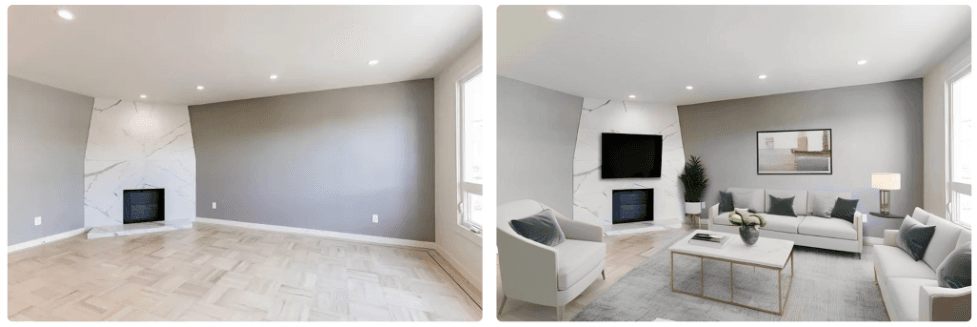 (Virtual rendering by Virtual Staging AI)
(Virtual rendering by Virtual Staging AI)
Furthermore, Virtual Staging AI’s newest decluttering feature allows the user to remove furniture and declutter the image of a room.
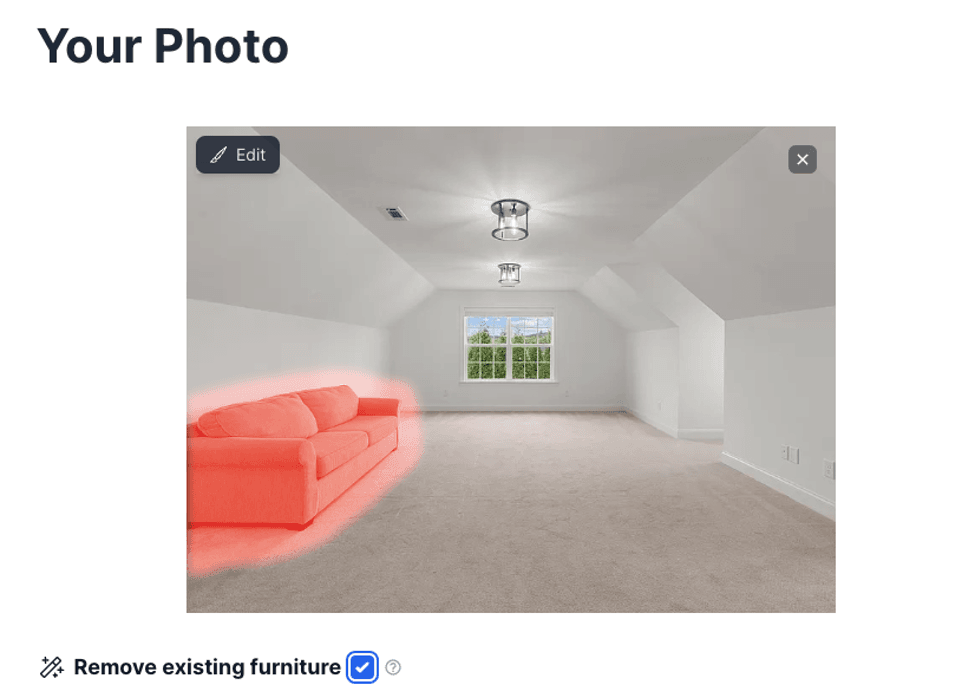 (Virtual rendering by Virtual Staging AI)
(Virtual rendering by Virtual Staging AI)
Decluttering an image before staging is free, so you can declutter and stage images with a simple watermark. To remove the watermark, upgrade to a paid plan (starting at only $12 for six photos).
Bonus Tip: When to Hire a Professional Home Stager
We mentioned earlier that hiring a professional to stage your listing is sometimes necessary. This is a great way to ensure that your property is in optimal condition for showings.
If you’re unsure whether to hire a professional home stager, consider the potential return on investment. Investing in professional staging services makes the most sense for properties with higher listing prices.
You can expect to pay up to $600 for the initial consultation with a professional stager and a recurring monthly fee of between $500 and $600 per room.
For an investment of that size, professional home staging may not make sense for listings with lower asking prices or rental properties outside the luxury sector.
Advantages of Hiring a Professional Home Stager
Although not inexpensive, one major advantage of hiring a professional home stager is its cost-effectiveness (in the right circumstances).
This is especially true if you consider how much it costs to have an empty property on the market for extended periods of time. Investing in professional staging can help sell a property faster and avoid the need for a price reduction.
Plus, hiring a professional home stager helps streamline the process. They style homes day in and day out, so they know the process very well and will typically be more efficient than if you take a DIY approach. With that, delegating to a professional conveniently takes this task off your plate.
Before
After
Stage Your Listing Like a Pro
The art of home staging is very beneficial to realtors since it gives them a powerful tool to sell homes faster for higher prices. It helps them make more money for their clients and earn a higher commission and an excellent reputation in the process.
This is all made possible since staging creates an environment that showcases a home’s potential and speaks to the desires and aspirations of buyers.
Virtual staging is an excellent option if you’re looking to maximize ROI while reaping the benefits of home staging. Head to the Virtual Staging AI home page to try the proprietary technology for free.
We use cookies and similar technologies on our website. See our cookie policy for more information.
